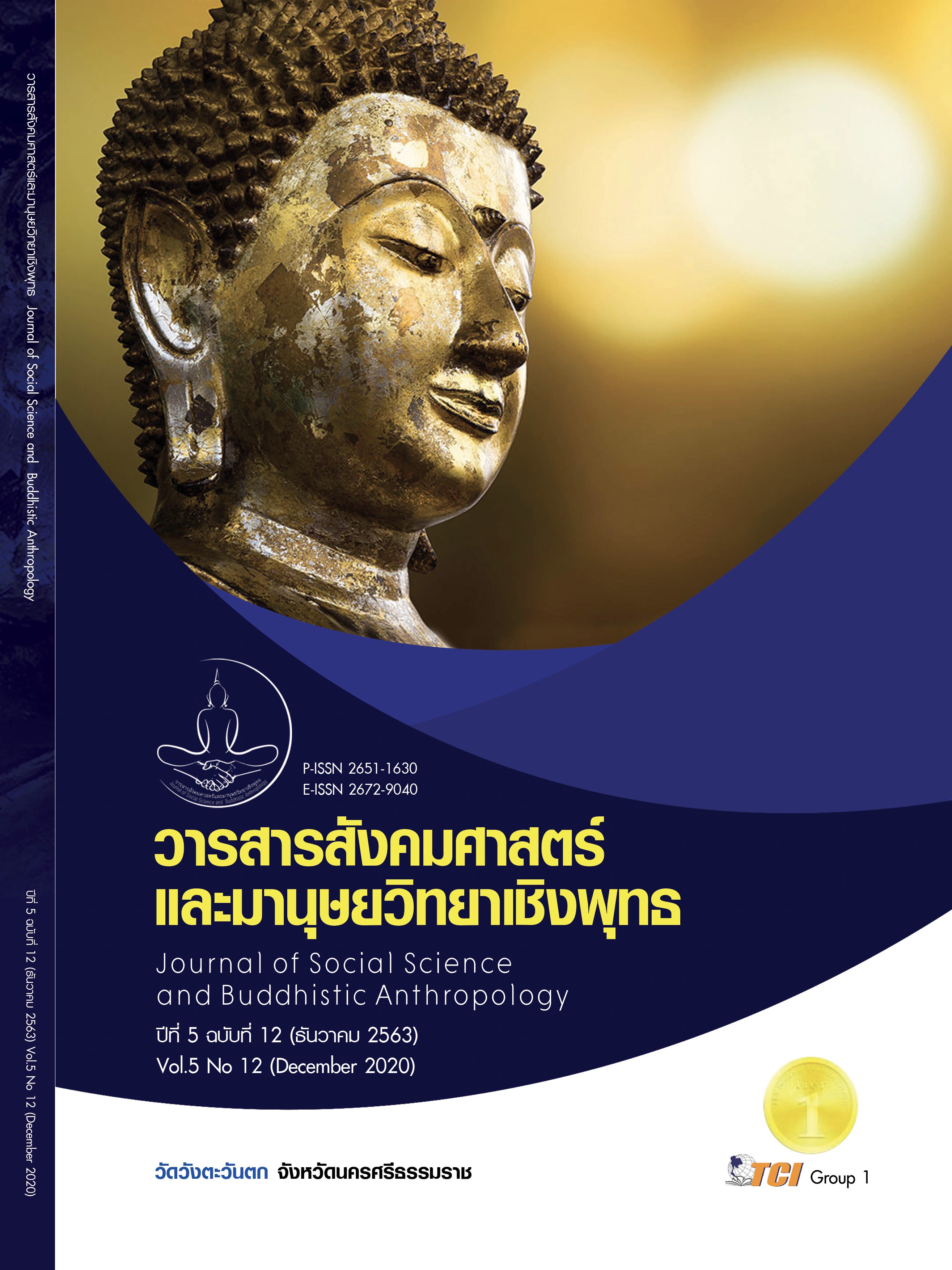THE EMPOWERMENT MODEL FOR ADDICTED PATIENTS AND FAMILY TO PREVENT RELAPSE
Keywords:
Empowerment, Addicted Patients, Family, Prevent RelapseAbstract
The Objectives of this research article were to: 1) to study the level of empowerment for addicted patients and family to prevent relapse, and 2) to study an empowerment model for addicted patients and family to prevent relapse. This research was a research and development model with 2 phases: Phase 1. study the level of empowerment for addicted patients and family. Use the questionnaire as a patient to be treated. Select a purposive sampling of 186 persons. Using statistics of percentage, average and standard deviation, and Phase 2, study an empowerment model for addicted patients and family. Use in - depth interviews and focus group as patients receiving therapy. Select a purposive sampling of 5 persons. Using content analysis and summarizing as an overview. The research found that: 1) level of empowerment for addicted patients and family to prevent relapse are: the individual characteristics of empowerment were important to the effectiveness of the prevention of repeated drug. Most are moderate, but have the lowest level of adherence characteristics, By is moderate level ( = 17.05 ,SD = 2.87) into 5 areas: 1) self-esteem awareness, 2) self-satisfaction, 3) ability to solve problems and manage situations, 4) adherence to commitment, and 5) self-development capabilities. And 2) The an empowerment model for addicted patients and family to prevent relapse. The an empowerment model for addicted patients was assessed covering 4 aspects such as: principle, purpose, structure content, and important aspects of the model. Be considered that the information obtained was appropriate, practical possibilities and practicality.
References
กรมควบคุมโรค. (2562). จำนวนผู้ติดยาเสพติดเดือนกุมภาพันธ์-พฤษภาคม พ.ศ. 2562. เรียกใช้เมื่อ 9 พฤษภาคม 2563 จาก http://probation.go.th/documents. php?id=153.
กาญจนา คุณารักษ์. (2555). การพัฒนารูปแบบการป้องกันการกระทำผิดซ้ำเกี่ยวกับยาเสพติด: กรณีศึกษาสถานพินิจและคุ้มครองเด็กและเยาวชน. ใน ดุษฎีนิพนธ์ปรัชญาดุษฎีบัณฑิต สาขาพัฒนศึกษา. มหาวิทยาลัยศิลปากร.
นวลศิริ เปาโรหิตย์. (2554). วิธีเปลี่ยนแปลงตนเองและไม่ยอมแพ้อุปสรรค. กรุงเทพมหานคร: บี มีเดีย.
นักจิตวิทยา. (9 ตุลาคม 2563). การพัฒนารูปแบบการเสริมสร้างพลังอำนาจผู้ป่วยเสพติดและครอบครัวเพื่อป้องกันการกลับไปเสพซ้ำ. (สายสุดา โภชนากรณ์, ผู้สัมภาษณ์)
นักบำบัดผู้ป่วย. (9 ตุลาคม 2563). การพัฒนารูปแบบการเสริมสร้างพลังอำนาจผู้ป่วยเสพติดและครอบครัวเพื่อป้องกันการกลับไปเสพซ้ำ. (สายสุดา โภชนากรณ์, ผู้สัมภาษณ์)
นักวิชาการ. (9 ตุลาคม 2563). การพัฒนารูปแบบการเสริมสร้างพลังอำนาจผู้ป่วยเสพติดและครอบครัวเพื่อป้องกันการกลับไปเสพซ้ำ. (สายสุดา โภชนากรณ์, ผู้สัมภาษณ์)
บริษัท มหาชัยเคเบิลทีวี จำกัด. (2563). โครงการแก้ไขปัญหายาเสพติดในระบบสมัครใจ. เรียกใช้เมื่อ 9 พฤศจิกายน 2563 จาก https://www.facebook.com/MCCableTV /posts/1655033964540087/.
บุญชม ศรีสะอาด. (2556). วิธีการทางสถิติสำหรับการวิจัย เล่ม 1. กรุงเทพมหานคร: สุวีริยาการพิมพ์.
ปารเมศ เสนาสนะ. (2560). ผลของโปรแกรมฝึกคิดเชิงบวกต่อความรู้สึกมีคุณค่าในตนเองของผู้ติดยาเสพติดหญิงในเรือนจำ อำเภอทุ่งสง จังหวัดนครศรีธรรมราช. วารสารสมาคมเวชศาสตร์ป้องกันแห่งประเทศไทย, 7(2), 189-199.
ผู้ป่วยบำบัด. (9 ตุลาคม 2563). การพัฒนารูปแบบการเสริมสร้างพลังอำนาจผู้ป่วยเสพติด และครอบครัวเพื่อป้องกันการกลับไปเสพซ้ำ. (สายสุดา โภชนากรณ์, ผู้สัมภาษณ์)
พยาบาล. (9 ตุลาคม 2563). การพัฒนารูปแบบการเสริมสร้างพลังอำนาจผู้ป่วยเสพติดและครอบครัวเพื่อป้องกันการกลับไปเสพซ้ำ. (สายสุดา โภชนากรณ์, ผู้สัมภาษณ์)
มรรยาท รุจิวิชชญ์. (2556). การจัดการความเครียดเพื่อสร้างเสริมสุขภาพจิต. ปทุมธานี: โรงพิมพ์มหาวิทยาลัยธรรมศาสตร์.
เรืองสิทธิ์ เนตรนวลใย. (2557). กระบวนการเข้าสู่การบำบัดรักษาเพื่อเลิกใช้ยาบ้าด้วยความ สมัครใจของเยาวชนไทย. วารสารสมาคมนักวิจัย, 19(2),36-44.
สถาบันบำบัดรักษาและฟื้นฟูผู้ติดยาเสพติดแห่งชาติบรมราชชนนี. (2563). จำนวนและร้อยละของผู้ป่วยนอกยาเสพติดของสถาบันบำบัดรักษาและฟื้นฟูผู้ติดยาเสพติดแห่งชาติบรมราชชนนี จำแนกตามปีงบประมาณ 2559-2563. เรียกใช้เมื่อ 9 พฤศจิกายน 2563 จาก http://www.pmnidat.go.th/thai/index. php?option=com_content &task=view&id=3290&Itemid=53.
สำนักงานคุมประพฤติจังหวัดสมุทรสาคร. (2562). โครงการบำบัดฟื้นฟูสมรรถภาพผู้เสพ ผู้ติดยาเสพติดจังหวัดสมุทรสาคร. เรียกใช้เมื่อ 9 พฤศจิกายน 2563 จาก http://www. probation.go.th/contentmenu. php?id=221.
สำนักบริหารการสาธารณสุข สำนักปลัดกระทรวงสาธารณสุข. (2556). ระบบติดตามและเฝ้าระวังปัญหายาเสพติด (บสต.). นนทบุรี: โรงพิมพ์ชุมนุมสหกรณ์การเกษตรแห่งประเทศไทย.
สุพรรณิการณ์ มาศยคง. (2554). คุณภาพชีวิตในโรงเรียนของนักเรียนมัธยมศึกษาตอนปลายใน กรุงเทพมหานคร. ใน วิทยานิพนธ์วิทยาศาสตรมหาบัณฑิต สาขาสถิติประยุกต์และเทคโนโลยีสารสนเทศ. สถาบันบัณฑิตพัฒนบริหารศาสตร์.
Cronbach, L. J. (1990). Essentials of psychological testing. New York: Harper Collins.
Gibson, C. H. (1991). A concept analysis of empowerment. Journal of Advanced Nursing, 16(1), 354-361.
Gibson, C. H. (1995). The process of empowerment in mothers of chronically ill children. Journal of Advanced Nursing, 21(2),1201-1210.
Kim,G.S., & Cho,S.H. (2001). Effects of hand acupuncture therapy on dysmenorrheal. Korean Journal of Child Health Nursing, 11(1), 109–116.
Krejcie, R. V. & Morgan, D. W. (1970). Determining Sample Size for Research Activities. Educational and Psychological Measurement, 30(3), 607-610.
Likert, Rensis. (1967). “The Method of Constructing and Attitude Scale” Attitude Theory and Measurement. New York: Wiley & Son.






